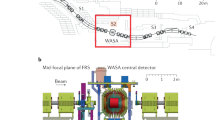Abstract
At the LHE JINR, an original approach to hypernuclear experiments was elaborated to produce relativistic hypernuclei. The production cross sections and lifetimes, τ, of 3Λ H and 4Λ H were measured successfully. The results of recent experiments on 5H and 7H nuclei suggest that the hypernucleus 6Λ H might be stable and that this may be the case even for 8Λ H. The unique quality of the spectrometer SPHERE may be used to identify unambiguously the isotopes of hyperhydrogen—through their pionic decay AΛ H → π − + AHe—including the new hypernuclei 6Λ H and 8Λ H with extreme values of N/Z of 4 and 6, respectively. The confirmation of the very existence of these neutron-rich hypernuclei would be a strong motivation to search for their spectra in strangeness and double-charge-exchange reactions (K −stop , π +) at FINUDA or (π −, K +) at J-PARC. It is very probable that, similarly as in 4Λ H, there is a low-lying state 1+ also in 6Λ H and 8Λ H. If their electromagnetic width (M1) is small enough, we could see two different values of τ for 6Λ H and/or 8Λ H. We investigate the spacings of the 1+ and 0+ states of 4Λ H, 6Λ H, and 8Λ H. The understanding of the structure of isospin asymmetric systems plays a key role in the description of systems as diverse as neutron-rich nuclei and neutron matter.
Similar content being viewed by others
References
B. Jonson, Phys. Rep. 389, 1 (2004).
A. Richter, Nucl. Phys. A 751, 3 (2005).
The Physics Case for EURISOL, Report of the Key Experiments Task Group.
T. Bressani, in Proceedings of the International School of Physics “E. Fermi”, Course 153, 2003, p. 323.
H. Bandō, T. Motoba, and J. Žofka, Int. J. Mod. Phys. A 5, 4021 (1990).
R. Chrien and C. B. Dover, Annu. Rev. Nucl. Part. Sci. 39, 113 (1989).
T. Hasegawa et al., Phys. Rev. C 53, 1210 (1996).
M. W. Ahmed et al., Phys. Rev. C 68, 064004 (2003).
L. Yuan et al., Phys. Rev. C 73, 044607 (2006).
A. Gal, J. M. Soper, and R. H. Dalitz, Ann. Phys. (N.Y.) 113, 79 (1978).
D. J. Millener et al., Phys. Rev. C 31, 499 (1985).
V. N. Fetisov et al., Z. Phys. A 339, 399 (1991).
Th. A. Rijken and Y. Yamamoto, Nucl. Phys. A 754, 27c (2005).
M. Ukai et al., Phys. Rev. C 73, 012501(R) (2006).
D. J. Millener, Nucl. Phys. A 691, 93c (2001).
D. J. Millener, Nucl. Phys. A 754, 48c (2005).
H. Tamura et al., Nucl. Phys. A 754, 58c (2005).
R. H. Dalitz, in Proceedings of the International School of Physics “E. Fermi”, Course 38, 1967, p. 89.
D. H. Davis and J. Pniewski, Contemp. Phys. 27, 91 (1986).
A. A. Korsheninnikov et al., Phys. Rev. Lett. 87, 092501 (2001); 90, 082501 (2003).
R. H. Dalitz, Nucl. Phys. A 754, 14c (2005).
L. Majling, Nucl. Phys. A 585, 211c (1995).
D. E. Lanskoy, in Proceedings of the International Seminar “Strange Nuclear Physics”, Osaka, 2004, nucl-th/0411004.
K. Kubota et al., Nucl. Phys. A 602, 327 (1996).
M. Agnello et al., Nucl. Phys. A 752, 139c (2005).
M. Agnello et al., Phys. Lett. B 640, 145 (2006).
P. K. Saha et al., Phys. Rev. Lett. 94, 052502 (2005).
T. Bressani et al., Nucl. Phys. A 754, 410c (2005).
P. Saha, T. Fukuda, and H. Noumi, Neutron-Rich A Hypernuclei by the Double-Charge-Exchange Reaction, LoI, J-PARC 03-6, 185.
K. J. Nield, T. Bowen, G. D. Cable, et al., Phys. Rev. C 13, 1263 (1976).
A. Abdurakhimov et al., Nuovo Cimento A 102, 645 (1989).
S. Avramenko et al., Nucl. Phys. A 547, 95c (1992).
G. Keyes et al., Nucl. Phys. B 67, 269 (1973).
H. Outa et al., Nucl. Phys. A 547, 109c (1992).
J. Lukstins, Nucl. Phys. A 691, 491 (2001).
S. Afanasiev et al., in Proceedings of the International Workshop on Relativistic Nuclear Physics: From Hundreds of MeV to TeV, Dubna, Russia, 2005, Preprint No. E1, 2-2006-30, JINR (Joint Institute for Nuclear Research, Dubna, 2006), p. 50.
T. R. Saito, Hypernuclei with Stable HI Beam Induced Reaction at GSI (LoI), http://gsi.de/document/DOC-2005-Feb-432-2.pdf.
R. H. Dalitz and A. Gal, Nucl. Phys. B 1, 1 (1962).
K. S. Myint and Y. Akaishi, Prog. Theor. Phys., Suppl. 146, 599 (2002).
J. Okołowicz, M. Płoszajczak, and I. Rotter, Phys. Rep. 374, 271 (2003).
G. Hagen, M. Hjorth-Jensen, and J. S. Vaagen, J. Phys. G 31, S1337 (2005).
N. Michel et al., Phys. Rev. Lett. 89, 042502 (2002).
J. Kotulič Bunta and Š. Gmuca, Phys. Rev. C 70, 054309 (2004).
I. Bombaci, Nucl. Phys. A 754, 335 (2005).
Author information
Authors and Affiliations
Corresponding author
Additional information
The text was submitted by the authors in English.
Rights and permissions
About this article
Cite this article
Majling, L., Gmuca, Š. What can we learn about baryon-baryon interaction from hypernuclei 6Λ H and 8Λ H?. Phys. Atom. Nuclei 70, 1611–1616 (2007). https://doi.org/10.1134/S1063778807090190
Received:
Issue Date:
DOI: https://doi.org/10.1134/S1063778807090190




